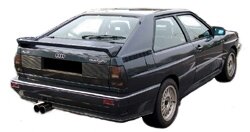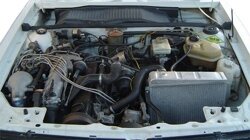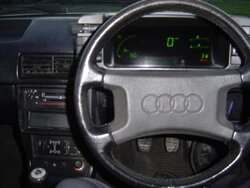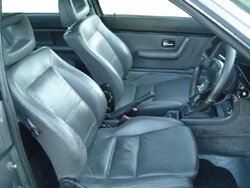Model Page
Audi Quattro

|
Production Run: |
11,452 |
|---|---|
|
Production Date: |
1980 - 1991 |
|
Engine: |
Audi 2.1 5 Cylinder 10v Turbo (80-87) Audi 2.2 5 Cylinder 10v Turbo (87-89) Audi 2.2 5 Cylinder 20v Turbo (89-91) |
|
Built: |
Ingolstadt (Germany) |
|
0-60: |
7.3 Secs (2.1 10v) 6.9 Secs (2.2 10v) 6.5 Secs (2.2 20v) |
|
Max Speed: |
139 Mph (2.1 10v) 143 Mph (2.2 10v) 146 Mph (2.2 20v) |

The Audi Quattro was first shown to a stunned public at the Geneva Motor Show on 3rd March 1980 and became the star of the show, the vehicle was a seismic shift away from Audi’s usual vehicles that were reliable, well built but thoroughly dull. The Audi Quattro was fitted with a turbocharged 2.1 litre five cylinder engine mated to a permanent four wheel drive system giving the car unrivalled performance and stunning handling.

Audi Quattro
It was chassis Engineer Jörg Bensinger that proposed the idea for building a four wheel drive car having been highly impressed with the performance of Volkswagens four wheel drive Iltis. The Iltis had been developed by VW to fulfil the needs of the German army to have a highly mobile transport vehicle for personnel, testing the vehicle in Finland in 1977, Bensinger was impressed with the performance of the vehicle in heavy snow conditions noting that no other vehicle on the test could match its performance. So impressed with the vehicle Bensinger contacted Audi’s Director of Technical Development Ferdinand Piech with the proposal to develop a four wheel drive variant of the Audi 80.
Ably assisted by the Director of Pre-Development Walther Treser, a prototype was built adding a rudimentary four wheel drive system to a modified Audi 80. Hans Nedvidek designed the four wheel drive system - essentially an evolution of the transmission found in the Volkswagen Iltis the system had no centre differential although one would be added before production was realised.
Audi sought permission from parent company Volkswagen to push the project through to production and so in early 1978 a test car was successfully put through its paces at Turracher Höhe and permission duly granted. Following the test, Volkswagen’s Director of Development allowed his wife to drive the prototype for a shopping trip to Vienna, upon her return the vehicle she complained that the car was difficult to park and the car suffered from “hopping”.

Audi Quattro
Addressing the issues that surfaced involved a redesign of the four wheel drive transmission. A centre differential was created by modifying a VW Polo differential, the gearbox output shaft was hollow through which power was distributed from the centre differential to the front wheels and to the rear wheels through a split prop shaft. To increase flexibility of the system Audi engineered front and rear differentials that had the ability to be locked thus providing greater traction in severe conditions. This ingenious setup provided a permanent four wheel drive system that was reliable, compact and remarkably lightweight. It was from the four wheel drive configuration that the car gained its name of “Quattro” which is Italian for four.
The model received independent front and rear suspension utilising MacPherson struts with coil springs and lower wishbones, anti roll bars being fitted to the front and rear of the vehicle. The rear suspension is identical to the front in all aspects apart from orientation, only early vehicles were fitted with the rear anti roll bar this being deleted shortly after introduction to reduce lift off over steer. 6J 15” Alloy wheels fitted with Goodyear 205/60 VR 15 tyres. The braking abilities of the vehicle were considerable thanks to the installation of servo assisted 280mm ventilated discs at the front and 280mm solid discs at the rear, braking was improved further with the addition of an anti lock braking system. Completing the vehicle was power assisted rack and pinion steering, headlamp washers and front a rear fog lights.
The Audi Quattro was styled by Martin Smith, the basis of the style was formed from the Audi Coupe, the Quattro received flared wheel arches, a flat front grill incorporating four headlamps lenses with integrated washer units, the unique front bumper housing front fog lights.
Audi setup a new production line in Hall N2 at their Ingolstadt factory in Germany, the line was manned by a small team of twenty operators Monday to Friday 06:00 to 14:00 unlike the rest of the factory that operated 24 hrs a day. The vehicles were not built on a conventional production line as each one was hand built taking over 40 hours of painstaking work to assemble each vehicle, upon completion each vehicle underwent a rigorous testing regime far stricter than was applied to any other vehicle. The tests included electronic checking of the suspension geometry, the engine being run through a test cycle and the vehicle being run on a test rig right up to 100 mph. Following the preliminary checks the vehicle was taken on a test drive covering ordinary roads and autobahns before taking to Audi’s test track to check for handling deficiencies, two stops were taken over the course of each trip to check for fluid leaks. Finally the vehicles were subjected to the rain test where the vehicle was showered in 3,500 litres of water over a ten minute period to highlight any leakages (normal production Audis were subjected to a thirty second test).

Audi Quattro Engine Bay
Power came from Audi’s single overhead camshaft 2,144cc 10 valve inline five cylinder engine that had been developed for the 200 5T saloon vehicle. The original engine had produced around 170 bhp which was healthy but needed boosting for the new model, modification included the installation of a single KKK 26 Turbocharger running boost at 12 psi, the addition of an intercooler and electronic ignition. The modified engine developed a creditable 197 bhp @ 5,500 rpm and 210 lb/ft @ 3,500 rpm
The Geneva Motor Show in 1980 was chosen as the place to debut the Audi Quattro. The new model was an immediate sensation generating huge interest from all quarters thanks to its perfect blend of style, power and remarkable four wheel drive system. At launch the vehicle was only available in left hand drive, buyers having to wait until late 1982 before Audi released a right hand drive equivalent. Motoring magazines duly put the car through its paces and was highly impressed by the package lavishing praise on the handling and traction achieved. However all was not good the car drawing heavy criticism for the flexibility of the engine at low speeds, it was found that at full power the Quattro was slower accelerating from 20 mph to 60 mph than a 0.9 litre Volkswagen Polo!

Audi Quattro Digital Display
In 1983 the front profile of the vehicle was changed somewhat with the introduction of single headlamp units, the original twin headlamps being deemed inadequate for driving at high speed. During this model year the vehicle received a talking digital dashboard with green digital display.
Further revisions were made, from 1984 the model benefited from a redesign to the interior with a new dashboard layout, revised steering wheel and newly created centre console, at this time the switches around the instrumentation panel were redesigned. The car received several mechanical updates with the addition of Bosch anti lock brakes, up rated spring rates and dampers and new 15” alloy wheels.
It was not until 1985 that the vehicle received a major overhaul with the release of the Quattro ‘facelift’ model. The facelift brought with it the introduction of a sloping front grille and headlights, smoked rear lights and the model designation badges on the boot were badges replacing the old transfers. A more aggressive stance was gained when the wheels were increased in size to 8x15” with 215/50-15 low profile tyres necessitating the modification of the front wings. At the same time the suspension was dropped 20mm and the suspension was tweaked with stiffer springs to improve handling.
It was not until the 1988 model year that the engine was replaced by the larger 2,226cc five cylinder engine. The engine retained its 10 valve single overhead cam alloy cylinder head but was reworked with hydraulic lifters, compression ratio increased from 7.0:1 to 8.6:1 and the engine not only had electronic timing but the ECU also controlled boost and fuelling. The unit gave a much better torque output at lower engine speeds the engine developed the same 197 bhp @ 5,800 rpm but an improved 199 lb/ft @ 3,000 rpm. At this point an electronic waste gate control system was installed and in order to meet German regulations twin piston callipers were fitted to the front brakes and the brake master cylinder was enlarged. Audi took the time to overhaul the transmission at this point replacing the central differential with a Torsen torque sensing differential. The vehicle had a revised 0-60 mph sprint time of 6.7 seconds and a top speed of 138 Mph.
In 1989 Audi released the Quattro equipped with the 2.2 20 valve RR engine, introduced to comply with tightening emissions controls. The RR engine was equipped with a double overhead camshaft cylinder head equipped with 20 valves radically increasing the breathing of the engine. The engine was equipped with the latest Bosch Motronic enginge management systems and the compression ratio was increased further to 9.3:1. AS standard the vehicle was fitted with twin catalytic converters but this did not restrict the engine too much and it now generated220 bhp @ 5,900 rpm and a hugely impressive 228 lb/ft @ 1,950 rpm. The 0-60 dash dropped to 5.9 seconds and the top speed stretched slightly to 141 mph.

Audi Quattro Leather Interior
It was at this stage in development that the range was taken further upmarket the interior being the main beneficiary. Deep pile carpets were fitted and most optional extras available previously became standard, finishing off the interior nicely was the introduction of the word Quattro being woven into the seat fabric and a new three spoke steering wheel.
Audi wanted to terminate production of the specialist Quattro but were unable to do as early as wanted due to outstanding orders, production soldiering on until the final vehicle was completed on 17th May 1991 the vehicle being replaced by the Audi S2.





